What makes a wine great isn’t a number or a score
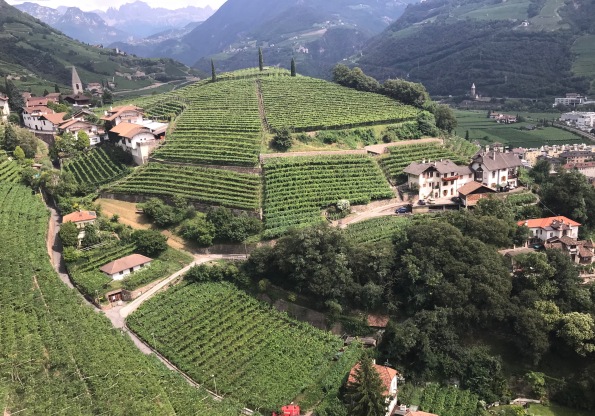
Steep hillside vineyards near Bolzano, Italy, illustrate the lengths to which wine makers will go to produce a memorable bottle of wine. Photos and story – Dave Buchanan.
Please indulge me while I share two separate conversations I heard recently.
The first from an acquaintance who recently returned from a late-fall trip to Napa Valley.
He and his wife, both discerning wine people with an appreciation for California-style wines, were visiting friends who introduced our couple to a fairly new but already successful winemaker.
During that initial conversation, the three quickly bonded and soon the winemaker was inviting his new friends to visit his winery, which normally isn’t open to the public. During a late lunch after touring his vineyards and winery, the winemaker graciously opened a couple of bottles from his personal library.
No sales pitch, no pressure, simply a gesture of friendship at our friends’ interest.
The wine, said my friend, “was a Cabernet (Sauvignon) and was simply stunning.”
Not surprisingly, at least to me, our well-funded friends brought a couple of these bottles back home to Colorado.
The second conversation, similar but with its roots 6,000 miles away, began when another acquaintance, this one a wine importer from Denver, remarked how he had met “too many to count” winemakers and their representatives while attending a wine festival in Verona, Italy.
“Almost everyone implored me to visit their winery and hear their story,” this friend recalled. So my friend, an impulsive sort, decided to take advantage of a couple of invitations.
“I saw some amazing estates and some tiny places where one family did all the work,” he said. “And mostly I tasted the same wines there that I tasted in Verona.”
But while sharing lunches and dinners in out-of-way bistros and private homes, he also got an insider’s peek at how Italians view their wines and its role in the everyday life. He gladly paid the extra baggage fees after being gifted a few bottles of Sangiovese-based Vino Nobile di Montepulciano.
Here is where our stories converge.
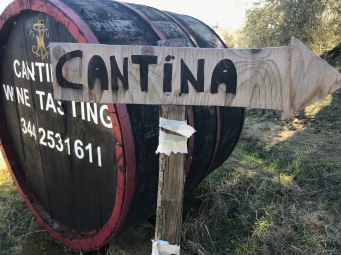
Nothing says ‘Welcome’ better than a friendly sign outside a neatly run winery.
Both men said that after arriving home, they invited over some friend to share the wines and hear their stories. And both, unknowingly but in similar words, told how the wines showed well but somehow something was missing.
“It’s not that the wines were less than great, they just weren’t that great, not like I remember,” said one.
“Everyone said nice things about the wine and were entertained to hear about how the winemaker’s grandfather had saved his wine from the Germans during World War II by hiding it under the stable,” said the other. “But to me, it just wasn’t the same wine.”
I was fortunate to taste both wines and both were way above what I normally drink. So it probably wasn’t the wines that were lacking. It was, both men affirmed, the experience of being there that made these wines memorable.
Seeing the vineyards, walking through the cellars, listening to the wine as it ages in the barrels, sharing a man’s or a family’s story. This, in great part, is what makes an unforgettable wine. Fortunately, both of these man realize that and neither is in any way disappointed by the wines.
“It’s always expectations versus reality,” one mused. “I know it won’t be the same once I get home but I want so much to share the experience.”
Today, social media (and extra baggage fees) allow us to share, from a distance both special and temporal, some of that experience. Still, it’s but a tantalizing taste of what wines are, what they can be, and what they mean to the people who make them.
The learning curve: one name, two wines
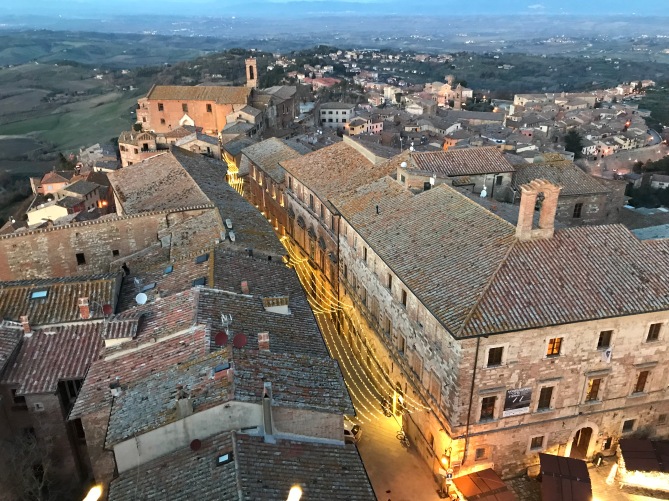
Montepulciano as seen from the bell tower in Piazza Grande.
Remember that oh-so-Tuscan hilltop village featured in the 2004 movie “Under the Tuscan Sun”? Then you’ve seen Montepulciano, Italy.
The village and town date from the Etruscan Period (4th-3rd centuries B.C.) and underwent several rounds of domination until the Florentines finally claimed it in 1511. In 1561, the town became autonomous and today it’s perhaps best known for its wine, Vino Nobile di Montepulciano.
In 1685, poet Francesco Redi named it “the king of all wines” and in 1980 this was among the first Italian wines to receive the strict Denominazione di Origine Controllata e Garantita (DOCG).
Vino Nobile di Montepulciano sometimes is confused with Montepulciano d’Abruzzo, although the latter comes from the province of Abruzzo and is made from the Montepulciano grape (I told you it can be confusing).
Vino Nobile, whose history goes back at least until 789, comes from Tuscany and is by rule at least 70 percent the local Sangiovese clone Prugnolo Gentile.
As Alfonso Cevola recently noted in his blog “On the Wine Trail in Italy,” it’s all part of the “distinct charm of the Italian state of mind to give unlike wines similar names.” And not just wines.
“Anyone who has driven in Italy,” Cevola writes, “and tried to find a town starting with the name of Colle, Castello, Rocca or Monte will recognize the dilemma. But, after all, it’s Italy and people have been finding their way around, eventually, to the town or the Café or the vineyard. Or not.”
Let’s go back to one of the first encompassing Italian wine books most of us read: Italian Wine for Dummies by Mary Ewing-Mulligan and Ed McCarthy. I’ll borrow this quote that Cevola pulls from the book:“The confusion is understandable, but these two wines are definitely different wines made from different grape varieties. Vino Nobile is a dry red wine made primarily from the Prugnolo Gentile variety (a type of Sangiovese) around the town of Montepulciano in southeastern Tuscany. Montepulciano d’Abruzzo is also a dry red wine, but made mainly from the Montepulciano variety, which grows in the region of Abruzzo on the Adriatic coast, southeast of Tuscany. The Montepulciano variety is believed to be native to the Abruzzo region, and it has no connection to Sangiovese or to the town of Montepulciano in Tuscany.”
Which is as clear as it can get, at least when you talk about Italian wines and grape varieties.
A New Year and the season for La Befana
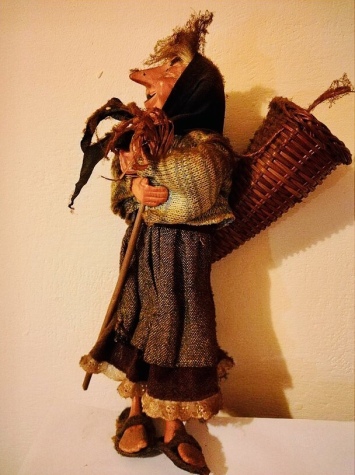
This kindly looking La Befana is not quite as scary as some traditions would have you believe. Photo courtesy of Wikipedia Commons
Chasing a dream: Amateur wines show character, flaws
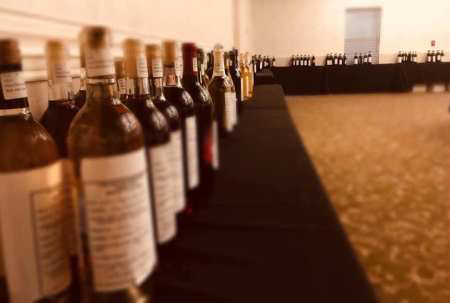
A portion of the 96 entries received this year for the Colorado Amateur Winemakers Competition. As in years past, red wines outnumbered all others. Photo by Cassidee Shull
On a crystal-bright Saturday morning in early November, I sat down at the Wine Country Inn with five other volunteer judges for the Colorado Amateur Winemaking Competition.
This annual wine judging is but one of the many wine-related events including Colorado Mountain Winefest produced by the Colorado Association for Viticulture & Enology (CAVE).
“This year we have 96 entries, including seven fruit wines, 17 white wines, two ice wines, five rosés and 65 red wines,” CAVE’s tireless executive director Cassidee Shull, who wrangled up the judges, countless wine glasses and a handful of wine openers, said as the day began. “We’ll taste through the wines and at the end choose the top wines to compete for Best of Show.”
That was pretty much the last we saw her as she spent the day, along with CAVE Program Director Melinda Tredway and hard-working volunteers Linda Keltner and Tiffany Sommers, shuttling carts loaded with wine glasses from the bottle room to the judges’ tables and back.
The judging offers amateur winemakers the opportunity to have their wines objectively assessed rather than relying on family and thirsty neighbors.
According to Orchard Mesa grape grower Rusty Price, the competition began at the 1994 Colorado Mountain Winefest at Palisade’s Veteran’s Park.
“The state wine industry was very, very small at the time (nine wineries), we didn’t even have a contest for the pros,” Price said. At the 1993 Winefest, he “hauled about 500 pounds of grapes” to the park for a grape-stomping event. That proved so popular he added an amateur winemakers’ competition the following year. “I think we had seven contestants and I didn’t enter because I was operating it,” said Price. “I think a lot of the wineries around now got their start at that contest.”
Price competed once, in 2000, and his Sunset Mesa Cellars Chardonnay won Best White Wine and Best of Show.
This year’s 96 entries from 27 winemakers provided “great insight into the growth of the Colorado Wine Industry as a whole,” Shull said. “These are the next generation of winemakers and grape growers ready to join this amazing industry.”
The eclectic mix of wines wasn’t unexpected, given the “who knows what will show up” history of the amateur contest.
“Annual entries are like the weather; you never know what you’re going to get,” judge Christine Feller said. “They are sometimes exceptional.”
While nothing this year was exceptional, there were some well-made and very nice wines.
“I really enjoyed the fruit wines,” offered judge Jenne Baldwin-Eaton, former winemaker at Plum Creek Winery and now teaching viticulture and enology at Western Colorado Community College. “They had matching aromatics and flavor.”
Incidentally, 1994 was the first year Baldwin-Eaton (it just Baldwin back then) attended Winefest and soon after landed a job with Erik Bruner, then Plum Creek’s winemaker.
The white wines, both dry and sweet, were generally well-received, a compliment in the sense there weren’t any overly faulty wines and several were close to commercial quality.
Baldwin-Eaton noted some work still needs to be done in the crucial area of balancing acid and sweetness in wines with residual sugar (remaining after fermentation). There also were oxidation (browning) issues in several of the white wines.
This “is part of what makes white wines more difficult to make,” Baldwin-Eaton said.
Red wines are buffered from oxidation by tannins and oak-aging, both of which add complexity to a wine.
That noted, the rosés and red wines received mixed reviews.
Pat Kennedy said “The improvements in the red wine is remarkable” while Feller, who has 20-plus years judging wines in this and other competitions, noted the red wines to her overall were disappointing.
There were “many flaws or challenges the winemakers couldn’t resolve,” Feller later wrote in an email. “Ordinarily, there are several remarkable reds.”
Kennedy, formerly at Talon Wine Brands, also mentioned tasting “seven or eight” oxidized wines.
The most-common flaw reported was over-extraction, caused by leaving the skins and juice together too long.
The process is desirable in some wines but uncontrolled can produce over-developed phenolics, chemicals affecting taste, color and mouthfeel of wines.
Not every winemaker will be pleased with their review but as Baldwin-Eaton noted, the competition offers amateurs valuable experience prior to starting a bonded winery.
“A lot of hard work and labor goes into making small-scale wine, and I am very appreciative of (the winemakers’) efforts,” she said. “By entering their wines and opening themselves up to constructive criticism and praise for what they are doing correctly, it lets me know that they want to improve and increase the quality of their efforts.”
Medals will be awarded Jan. 15 during the 14thannual VinCO Conference & Trade Show at Two Rivers Convention Center. Information at winecolorado.org.
The challenges amateurs face
Why doesn’t every amateur winemaker make wines as good as the pros? Lack of experience, yes, but state enologist Stephen Menke said the biggest holdback for amateurs might well be the cost of good equipment.
Much amateur wine is made in someone’s basement or garage in glass or plastic jugs known as carboys ranging from ½-gallon to 15 gallons.
“For amateurs it’s all self-financed so they tend to go cheap, maybe even water-down the fruit,” Menke said. “It’s hard to do professional style and quality on a really low budget.”
White wines are especially difficult given the special equipment needed to regulate temperatures during fermentation.
White wines “are trying to showcase the varietal fruit components of the wine,” Jenne Baldwin-Eaton said. “If anything goes wrong with a white wine fermentation, it will be hard to hide and you will have lost the nice fruit components.”
Pat Kennedy said during his years at Talon “we worked hard at the cold-stabilization stage in the aging process for the white wines.
“I would imagine that an amateur winemaker wouldn’t have the equipment to chill the wine and keep it cold for a long period of time.”
A major concern, shared with commercial winemakers, is keeping things clean.
“You can get bottle acidity, oxidation, and even some bacterial infections if you don’t pay attention to the details,” Menke said, noting that professionals have the experience and the equipment to deal with such problems.
“The most important thing is knowing how to clean your equipment,” he said. “Eighty percent of our time is spent making sure things are not contaminated.”
What’s in the Glass: Le Pigioulet Vaucluse
 Le Pigoulet (Vin de Pays de Vaucluse), $22 MSRP: This deep-gold vin blanc from southern Rhone producer Vignobles Brunier (producer of the flagship Le Vieux Télégraphe) offers a nose of white fruit, pears and spice and herbs. It’s a lovely blend of 30 percent Rousanne, 30 percent Grenache Blanc and 40 percent Clarette.
Le Pigoulet (Vin de Pays de Vaucluse), $22 MSRP: This deep-gold vin blanc from southern Rhone producer Vignobles Brunier (producer of the flagship Le Vieux Télégraphe) offers a nose of white fruit, pears and spice and herbs. It’s a lovely blend of 30 percent Rousanne, 30 percent Grenache Blanc and 40 percent Clarette.
The Rousanne component, a mix of white flowers, peaches, pears and spice brings a depth of food friendliness to this wine, which I first was served at the restaurant 626 on Rood in Grand Junction. Co-owner and wine buyer Brenda Wray has built an extensive and fulfilling wine list, one she changes on a regualr basis.
“I really loved this wine the first time I tried it,” she said recently. “I like the fact that’s it’s so food friendly and goes well with our menu.”
Mother’s Day gets ‘Uncorked’ in the West Elks AVA
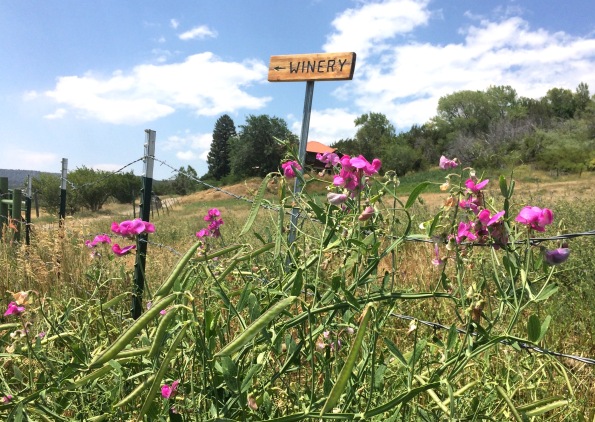
Mother’s Day offers the perfect beginning to a season of winery related dinners and special events in the West Elks AVA and the North Fork Valley. Photo and story by Dave Buchanan.
Some notes on events taking place in the West Elks AVA marking Mother’s Day (Sunday May 13) and beyond:
Mother’s Day Brunch at Alfred Eames Cellars – This is the first in a summer series of monthly smorgasbord-style brunches hosted by Eames and Pam Petersen. Hours: 10 a.m. until 2 p.m., cost is $15 for all you can eat (or until the food runs out). Live music from 11-2 featuring David Sheppard. Reservations requested but not required. Information and directions: 970-527-6290 or www.pams-jammin.com. Email: pvinsong@gmail.com. 11931 4050 Rd, Paonia.
Mother’s Day Dinner featuring Stone Cottage Cellars – The wines of Stone Cottage Cellars and the culinary talents of Chef Chelsea Bookout will be featured Sunday at the Locavore at the Auction House dinner, 530 Grand Ave., Paonia. 6:30 p.m., five courses paired with Stone Cottage Cellars wine, $70 per person. Reservations: PaoniaBreadWorks@gmail.com or 970-527-5376.
North Fork “Uncorked”, which highlights the wineries of the North Fork Valley and West Elks AVA wine country, this year happens June 15-17. Special wine dinners and events throughout the weekend, including two full days of tasting the newest releases and special food pairings at all participating wineries. Dinners are scheduled for June 15 at SkyHawk Winery and Leroux Creek Vineyards; June 16 – Stone Cottage Cellars, and June 17 at Alfred Eames Cellars (9 a.m.- 1 p.m. brunch only). Information: WestElksAVA.com or 970-390-4251.
What’s in the Glass: Ravenswood 2015 Belloni Vineyard Zinfandel
Ravenswood 2015 Belloni Vineyard Zinfandel – $39 MSRP. Lush, bright, rich with boysenberry, spice and loads of dark fruit. That’s the easy part.
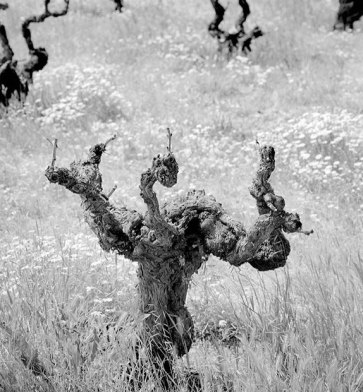
These gnarled vines provide the lush fruit for Ravenswood’s Belloni Vineyard Zinfandel. Photo courtesy Ravenswood.
The story line on the Ravenswood website says winery founder Joel Peterson (is there a Zinfandel drinker who doesn’t know about Joel Petersen?) was first surprised and then enthusiastic when he initially saw the 90-year old vineyard Ricardo Belloni and his wife Natalia were farming in the Russian River Valley near Santa Rosa.
That was circa 1991 and ever since Peterson has used Belloni fruit to create deeply balanced and satisfying wines. While the 2015 vintage was challenging for most winemakers – drought and a cool spring (May average temperatures were reported below the January average) resulting in smaller crops – the Belloni vines provided a high-quality harvest. Drink now through 2025.
Is it sustainable? Focusing on a living wine and a healthier world
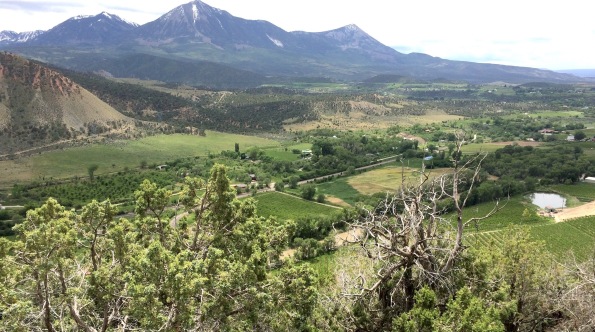
The fields, orchards and vineyards of the North Fork Valley provide a living laboratory for a hot-bed of awareness in low-impact agriculture. Cutting-edge techniques combined with methods gleaned from ancient cultures may provide insights to protecting a fragile environment. Story and photos by Dave Buchanan.
Even while our society is awash in products ranging from clothing to fine dining labeled as natural or organic, confusion abounds for consumers and often producers.
Partly it’s because the rules or guidelines that define what those terms actually mean confound most parties.
It’s also partly because consumers interested in “being green” can’t always find products that fit their expectations.
According to a 2009 study by the Grocery Manufacturers Association and the research firm DeLoitte, 54 percent of the more than 6,400 shoppers polled showed a preference for environmentally friendly products but only 22 percent actually bought green.
Several reasons were outlined in the study, major among them “communication and product education,” said the report.
“We found … it’s not enough to just put green products on the shelf,” said Brian Lynch, GMA director of sales and sales promotion. “We have to better educate consumers and leverage in-store communication to make the sale.”
It’s not so different in the world of winemaking. Wines can carry such varied labels as “low sulfite,” “natural,” “organic” or even “made with organic grapes,” all of which mean something different, and often nothing, to the consumer.
Broadly speaking, you can lump all winemaking under one of two processes: conventional and sustainable.
Conventional is how the great majority of winemakers pursue their art. Pesticides, herbicides and fungicides in the vineyard; preservatives, color enhancers and custom yeasts to provide desired flavors may be added in the winery.
“Sustainable” winemaking is the umbrella under which you’ll find natural, organic and biodynamic methods of winemaking. The rules get progressively more restrictive as you moved from natural to biodynamic.
According to the website RawWine.com, natural wine is farmed organically or biodynamically, following the strict procedures delineated by Rudolf Steiner, with minimal intervention in the vineyard and the winery.
“The result is a living wine – wholesome and full of naturally occurring microbiology,” said the website.

Author and sustainability expert Sandra Taylor (right, in red) discusses her latest book, “The Business of Sustainable Wine” during VinExpo 2018 with Molly Clemens, a Ph.D student of Ecology at San Diego State University. Taylor’s book explains how sustainable agriculture may be our only cogent response to human-caused climate change.
Author Isabelle Legeron, MW, in her book “Natural Wine,” says a natural wine is one that can survive without a “technological crutch.”
“In its truest form,” writes Legeron, “it is wine that protects the microcosm of life in the bottle in its entirety, keeping it intact so that it remains stable and balanced.”
Sustainability includes using no additives or processing aids, including yeasts, in the fermentation process.
In her new book “The Business of Sustainable Wine,” Sandra Taylor says wine, unlike most other agricultural products, allows both producer and consumer to focus “on the wine grape’s place of origin and the details of the wine’s making.”
Taylor is a former executive for Starbucks Coffee, where she helped develop guidelines for Starbucks’ innovative work in sustainability for coffee, tea and cocoa.
I spoke with Taylor during Vinexpo 2018 in early March at the Javits Center in New York and during our conversation, she noted that despite a growing interest and awareness in a wine’s origin, the wine industry is lagging behind in sustainable agriculture, both in environmental terms and in meeting consumers’ growing demands.
In her book, she also draws a line between “sustainable” agriculture (including economic, social and environmental sustainability) and organic and biodynamic practices.
While Rachel Carson’s landmark 1962 book “Silent Spring” is universally heralded as ushering in the age of environmentalism, it wasn’t until the 1980s that Americans “began to seriously consider” where their food comes from or “what food production does to the planet, their bodies and their society,” Taylor writes. Her book is available through Grand Valley Books, 350 Main Street, in Grand Junction and other book sellers.
Other writers, including poet and environmentalist Wendell Berry, Frances Moore Lappé (“Diet for a Small Planet”) and ecologist Barry Commoner, further introduced Americans to the impacts of industrial farming and the benefits of sustainable farming.
Over the next few weeks, I’ll be talking to many winemakers who produce sustainable wines, including a group of more than 100 Italian winemakers at Vini Veri, the annual fair and exposition in Cerea, Italy, a small town in northern Italy a few kilometers south of Verona.
Those producers adhere to a dictum that avoids pigeonholing wineries as “bio” or “non-bio” but rather emphasizing, as the Vini Veri website states, “the best balance between human intervention and nature in the winemaking process.”
Next time, we’ll talk more about sustainability in winemaking and look at how it is practiced in Colorado winemaking. (Spoiler alert: Not so much.)
A tradition of hard work brings good news for lovers of Spanish wines
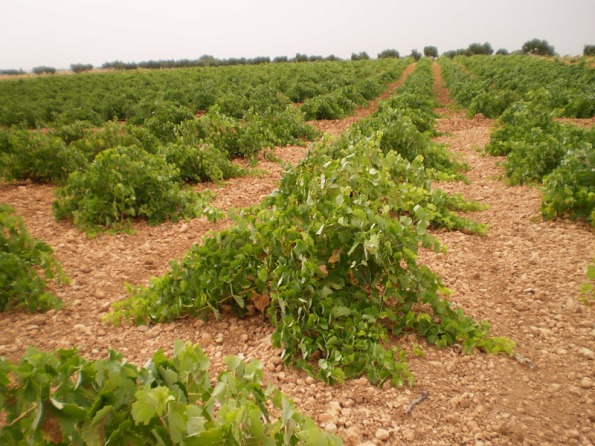
The farmers of Bodegas Zagarrón use both the traditional style of goblet or bush vines in the windswept plateau region of southeast Spain as well as using espalier (or cordon) viticulture. Photo courtesy Bodegas Zagarrón.
Bodegas Zagarrón in Mota del Cuerva, Spain, isn’t a single winery or vineyard, at least not in the traditional sense. It’s a cooperative of around 780 families farming more than 5,000 hectares (about 12,400 acres) in the windmill-dotted high plains of southeast Spain.
Mota del Cuerva is in the heart of La Mancha, about halfway between Madrid and Valencia on the Mediterranean Sea.
It’s a land of windswept plateaus cut by steep river gorges, and its elevation of more than 900 meters (3,000 feet) produces relatively mild winters and hot summers.
With the proximity of Valencia, most of the Coquense, as the locals are known, speak both Spanish and Catalan. Winemaking in the region goes back 200 years or more, but it wasn’t until after 1948, when local winemakers decided to pool their efforts, that the area has become internationally known.
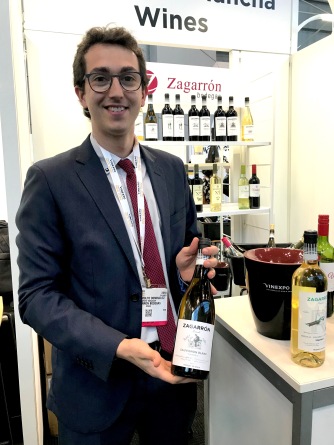
Carles Moltó Domínguez, the personable American sales representative for Bodegas Zagarrón, says his current favorite is the Sauvignon Blanc. Photo and story by Dave Buchanan
“The wines we produce in the bodega represent the traditions of our city and our people,” said Carles Moltó Dominguez, the Zagarrón representative. “Our city is very old (founded by the Muslim Arabs in 714) and it has had a culture of wine and working with grapes for more than 200 years.”
I met Dominguez in early March at VinExpo 2018, held at the Javits Center in New York.
He explained that pooling resources allowed winemakers to modernize their winery and share the costs of production, shipping and marketing. A massive modernization of the facilities in 2005 brought state-of-the-art technology and this dynamic gathering has helped the forward-thinking Bodegas Zagarrón win more than 60 award in international wine competitions.
But the past isn’t forgotten, Dominguez assured me.
“The people of Cuenca have a long tradition of hard work and working with wines and we want to reflect and honor this tradition in our wines,” said Dominguez. “We believe these wines are a result of that long tradition of hard work” in the vineyards.
The main varieties produced include such classic Spanish grape varieties such as Tempranillo, Airén, Macabea, Verdejo and Sauvingnon Blanc.
Today, the modern, high-volume winery produces well-made wines retailing for under $12 a bottle, all carrying the La Mancha DO (Denominación de Origen).
We tasted though Zagarrón’s selection of Tempranillo-based red wines, including a 100 percent Tempranillo, a Tempranillo/Petit Verdot blend and a Tempranillo/ Syrah blend.
When I mentioned I was partial to the Termpranillo Syrah blend, with its smooth tannins and deep flavors of red and black fruits, Carles Moltó Dominguez smiled.
“It’s very nice, isn’t it? Very food friendly,” he said.
And when pressed, he held out the 2017 “Garbeo” Sauvignon Blanc.
“This is my favorite, at the moment,” he said.
The elegant, well-balanced Sauvignon Blanc sparkled light gold under the harsh lights of the convention center, offering a nose of citrus and floral notes. In the mouth, the wine’s distinctive personality came out, revealing hints of citrus and tropical fruit, admirably offset by a gentle touch of grassiness and wet-stone minerality.
When it was mentioned the wine probably could command a higher price, Dominguez laughed and shrugged.
“You have to remember this is Spain, and a Spaniard knows very well how to enjoy the smaller things in life and how to be happy with very little,” he said. “While we obviously like money in Spain, it’s not the most important thing to us. Our prices reflect this philosophy.”
It’s time for a change, but is it spring or another blast of winter?
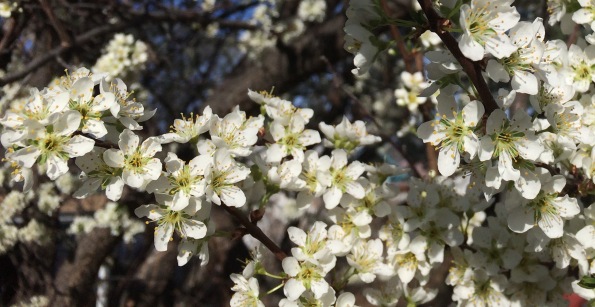
Early heralds of the season to come, these plum blossoms may or may not survive to produce fruit, depending on the weather. Some fruit growers in western Colorado say they get plums and apricots about one year in 10. Story, photos by Dave Buchanan
A change is coming to the high desert of western Colorado. Observant hikers already have noticed miniscule blossoms poking out from desert shrubs, including such early bloomers as shadscale and saltbush.
In the city, winter-weary eyes are greeted by puffy blossoms of plum, apricot and serviceberry, glowing popcorn-white against winter-dark wood.
For fruit growers, however, this means restless nights, knowing it won’t be long until their sleep is broken by the roar of wind machines keeping the frost at bay.
Meanwhile, the vineyards sleep on. Even as eager gardeners eye emerging crocuses and dig into the cool soil as if spring were buried there, the vines wait unperturbed.
The vines are not fooled.
“Everything is still pretty much asleep,” noted Horst Caspari, state viticulturist at the CSU Orchard Mesa Research Station. “They don’t wake up very quickly. Each week they lose some of their cold-hardiness and each week they get closer to waking up.”
Caspari let his eyes wander to the apricot and pluot trees outside his window at the research station near the northwest corner of B and 32 roads on Orchard Mesa. He doesn’t harvest the fruit; the trees are there for decoration and to act as Nature’s calendar of seasons.
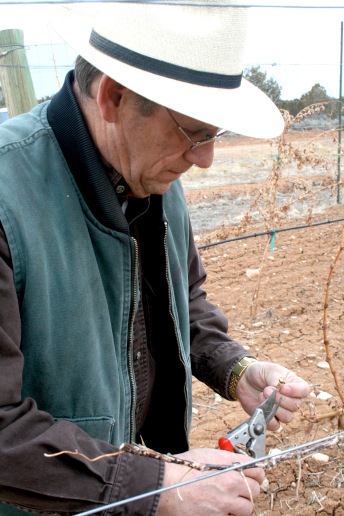
Winemaker Guy Drew of Guy Drew Vineyards in McElmo Canyon near Cortez in southwestern Colorado checks some early bud development in his grape vines. Growers regularly monitor bud growth and survival, looking for hints of the crop to come.
“Once the trees and vines get to bud break, all the cold hardiness changes,” he said. “Look at the apricots. I’d expect we’ll see the first flowers in the valley this week but if it drops to 29 degrees, you’ll lose them.”
Bud break, when nascent buds emerge from the protective cover and show themselves to the world, is when spring really arrives in the Grand Valley, no matter what the calendar or the thermometer says.
When a visitor remarked that his plum tree was “thisclose” to flowering, Caspari laughed.
“Well, you probably won’t have any plums to pick up this fall,” he said.
Records suggest that the last spring frosts are coming come earlier and the first fall frosts arriving later, adding a few days on each end of the Grand Valley’s growing season.
Caspari, who refers to killing frosts below 30 degrees, said that in the 54 years of records the Research Station has kept, the median date for the last frost (below 30 degrees) is April 25 while the first fall frost comes around October 23.
That’s not absolute, he emphasized.
“In 2016, we got hit pretty hard when we had 19.8 degrees on Nov. 16,” he said.
In those years, the same records indicate the valley has picked up “about a week” of frost-free (i.e., not a killing frost) growing, Caspari said.
A few days in the spring and about the same in the fall.
“We definitely have changed in the fall,” he said.
Of course, the changes are not limited to western Colorado.
NASA reports the average global temperature has increased about 0.8-degree Celsius (1.4-degrees degrees F) since 1880.
Two-thirds of that, says NASA, has occurred since 1975, just about the time U.S. wines broke onto the world’s stage at the famed Judgment of Paris.
During the 2017 Vinexpo in Bordeaux, France, growers and winemakers alike voiced concern about a warming climate and its effect on winemaking.
“Vines are very sensitive plants,” Gaia Gaja, co-owner of the 159-year old Gaja Winery in Barbaresco, Italy, told the French Press Agency. “They’re like a thermometer. They register every little variation that there is around them.”
Which brings us to spring of 2018, where things are bit behind last year.
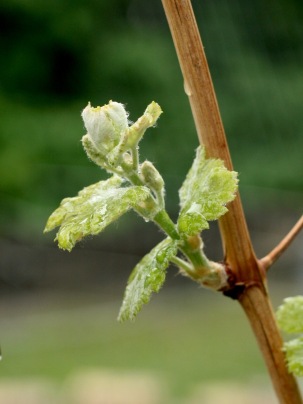
Late March still is too early in the Grand Valley for grape tendrils but it won’t be long until delicate leaves such as these add a shade of green to brown vines.
“I keep track of the budding time of my flowers, my bulbs, and it’s been pretty fascinating,” winemaker Nancy Janes of Whitewater Hill Vineyards said recently. “It has not been unusual historically for me to have crocuses bloom in the middle of February and this year my crocuses are just blooming right now.”
She said the warm days have been balanced by nights dipping into the low 30s “and that’s keeping things pretty dormant.”
Caspari also noted that the spring so far is about two weeks behind 2017.
“Last year we had bud break in the second week of March and we don’t normally get bud break in Chardonnay until the fourth week in April,” he said.
One way to look at the spring re-awakening, said Caspari, is to envision a circle, with winter cold at the bottom and spring warmth at the top. Does the temperature rise gradually, following the arc of the circle, or is there a sudden bottom-to-top jump, bridging the gap and going quickly from winter to spring?
“That changes how you think about what you have to do to have a crop,” Caspari said.
Most grape growers are busy pre-pruning, getting ready for that last flurry of cutting and shaping when the growing season finally arrives. Will it come with a rush or will western Colorado sink back into another spell of winter, delaying the bud break and pushing development later into fall?
Nancy Janes gazed out of her winery at the still-sleeping vineyard sloping away to the north. A few clouds could be seen drifting far over the Bookcliffs in the pale, late-winter sky.
“So far, it’s been a very nice winter for us,” she said. “And you know, grapes aren’t fooled easily. They know when things are ready.”